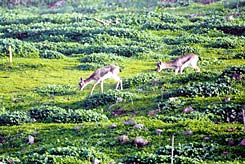Zafarir Rinat

In the past, the large herds of Eretz Israeli deer, observed in the south of the Golan Heights, were one of the great sources of pride of the Nature and Parks Authority. The 5,800 individuals that roamed the area were an expression of the authority's success in protecting wildlife in Israel. However, from the deer count that was conducted yesterday, the PA's personnel returned particularly dejected and worried. They discovered in the count that the process of the sharp decrease in the number of deer continued; Authority personnel counted a total of 165 deer, a significant decrease compared to the 200 individuals counted last year. Also in the Ramot Issachar region, north of Beit Shean, there is a steep downward trend in the number of deer; Yesterday, 995 deer were counted there compared to 1,884 last year.
Following the findings of the count in the south of the Golan Heights, the Director General of the Nature and Parks Authority, Eli Amitai, decided next week to convene an urgent discussion of all the professional bodies in the authority, in order to try and find ways to protect the deer and restore the population.
Twenty years ago, 5,800 deer lived in the basalt plains of the southern Golan Heights. They multiplied thanks to the abundance of food sources and the protection of the inspectors of the Nature and Parks Authority (then the Nature Reserves Authority), who managed to considerably reduce illegal hunting. The Nature and Parks Authority even decided to thin out the deer population, to prevent the spread of diseases and reduce damage to agriculture caused by the deer. Even after this thinning, which was stopped in 1993, there were still 3,200 deer left in the south of the Golan Heights.
Since then, a steep decline in the population began, and within six years it shrank to nearly 70%. According to the census conducted in 2000, there were 450 deer in the south of the Golan Heights. Now it turns out that within five years the population has again shrunk by more than half.
"For the past three years, we have conducted a study, led by Prof. David Saltz from Ben Gurion University, on the causes of the decline in the deer population in the Golan Heights," says Didi Kaplan, the ecologist of the North District of the Nature and Parks Authority. "The research shows that the main cause of the decline is predation by jackals and wolves."
In recent years, the number of illegal waste sites in the Golan Heights, and the sites where animal carcasses are dumped, has greatly increased. As a result of this food supply, the number of jackals and wolves increased greatly, and they began to devour the deer in large quantities. "In the research we conducted, we saw that the main problem is the inability of the deer population to maintain a high number of adolescent deer," Kaplan explains. "We know that there are litters and there should have been deer, and we know that young deer are not harmed by illegal hunting, but mainly mature deer. Therefore, the conclusion is that it is mainly predation. Regarding Ramot Issachar, it is still too early to draw conclusions, but it is possible that a similar process of predation pressure is beginning in this area as well, which harms the population."
The Authority now believes that the great thinning that took place twenty years ago caused a more serious damage than expected to the deer population in the Golan Heights. As a result, a slow decline process began, a situation in which threat factors such as predation or hunting, become much more significant in weakening the population.
Following the research conducted in recent years, the Authority decided to adopt an extensive thinning policy of jackals and at the same time the Authority's personnel and the Ministry of Environment began to work to close waste sites and dispose of animal carcasses. In the last two years, about 700 jackals were shot every year by the PA's inspectors. In the meantime, this has no effect on the size of the deer population and it continues to decrease, but the Authority hopes that a thinning that will continue for several years will reduce the number of deer that are killed, and their population will begin to recover.
https://www.hayadan.org.il/BuildaGate4/general2/data_card.php?Cat=~~~75966611~~~32&SiteName=hayadan
